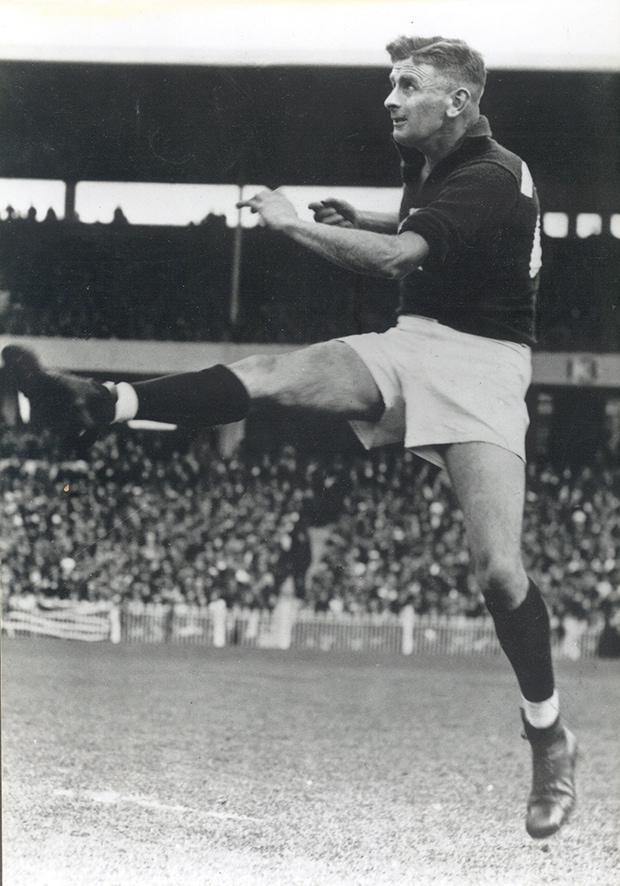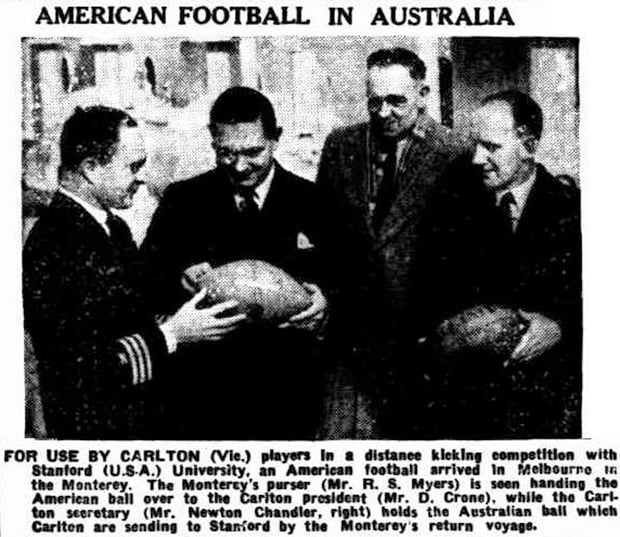With Jarryd Hayne making incredible in-roads for the San Francisco 49ers and thoughts turning to the late Carlton reserve grade player Colin Ridgeway’s forays with Dallas in 1965, this club’s connections with American football can be retraced further, to the late 1930s and a unique kicking competition involving ’Frisco’s Stanford University.
The idea originated in 1936 when footballs (such as the one pictured here from Stanford’s Pacific Coast Conference Championship year of 1934) were exchanged between the two parties – as were letters between the then Carlton secretary Newton Chandler and The Sporting Globe’s university’s representative Archie Richardson, a one-time member of the Richmond Cricket Club and a close friend of Carlton committeeman Jack Best, in San Francisco.
At the time Chandler predicted: “within a few years football matches, similar to the Australian Code, would be played between the two countries”.
“With interest being created overseas there is an undoubted possibility that the Australian code will yet become an International game,” Chandler said.
On Grand Final day 1937, at half-time of the match between Collingwood and Geelong, four noted Blueboys - Frank Gill, Eric Huxtable, Keith Shea and the legendary Harry “Soapy” Vallence – gathered on the pea green surface of the MCG.

Carlton legend Harry Vallence. (Photo: Carlton Football Club)
The quartet committed their energies to the inaugural international kicking contest involving players from Stanford, notably Jim Groves, Glenn Hamilton, Peter Fay, Jim Groves, Tony Calvelli, William Paulman and J. Steers.
Gill, Huxtable, Shea and Vallence kicked on that last Saturday in September, with Stanford players following suit at a venue unknown on October 12.
The Carlton and Stanford kicking contest of ’37 was refereed by the New Zealand-born Mr. JT Wylie, formerly a member of the New South Wales Waratahs of 1912 and New Zealand All-Black of ’13.
The contest, which involved the use of both the Australian and American footballs, was won by the Blueboys. With the punt kick, Vallence took line honours, booting each ball 69 yards. As for the long-gone drop, Huxtable emerged the victor with yardage of 67 and 65 for the Australian and American leather conveyances respectively.
Stanford players alone participated in the place kick and throw. Winner of the placekick was Paulman with a distance of 58 yards for the Australian football and 59 for the American version; while champion thrower was Steers (61 yards with the Australian football) and Hamilton (68½ the American).
In Carlton’s 1937 Annual Report, Chandler reported that the distance attained in drop kicking by the Carlton players “was a revelation to the Americans”.
“They also thought the Carlton punt kicking was good, although the American record for this type of kick is 91 yards,” Chandler wrote.
“The amazing feature of the contest was the distances both types of balls were thrown by the Stanford players . . . there certainly appears to be good reason for the throw being banned in Australia.”

Stanford University visits the Carlton Football Club (Source: Perth Mirror, August 21, 1937)
The Carlton-Stanford International Kicking Contest was again staged the following April, in the former’s Premiership year of 1938. Once again the Blues emerged victorious on aggregate.
In April of ’39, though the Carlton players had to “complete their portion of the contest hurriedly on the one evening in the limited space of daylight between 5.15 and 6 o’clock”, they again held sway overall.
Individually, Carlton’s Frank Gill drew gasps with a 70-yard drop kick of an Australian footy, with Stanford’s Paulman achieving a tad over 76 yards placekicking the Aussie ball.
“There is pleasing evidence that these contests are creating a friendly feeling between the Californian people and the public of Victoria,” Chandler noted.
“The number of visitors from America who take the opportunity of attending League grounds to see the Australian game is increasing year by year, and the favourable impression created by our pace of the game, the high marking and long kicking is a tribute to our Code.”


